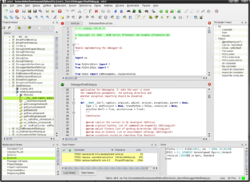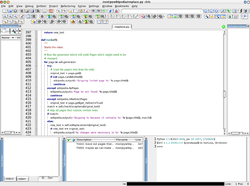Eric (software)
 | |
|
eric4 running in KDE SC 4 | |
| Original author(s) | Detlev Offenbach |
|---|---|
| Developer(s) | Detlev Offenbach |
| Initial release | 2002 |
| Stable release |
6.1.10
/ October 8, 2016 |
| Repository |
die-offenbachs |
| Development status | active |
| Written in | Python |
| Operating system | Linux, Microsoft Windows, OS X |
| Platform | Python, Qt, PyQt |
| Available in | English, German, French, Russian, Czech, Spanish, Italian, Turkish, Chinese |
| Type | Integrated Development Environment |
| License | GPL "version 3 or later" |
| Alexa rank |
|
| Website |
eric-ide |
eric is a free integrated development environment (IDE) used for computer programming.
eric is a full featured IDE, providing by default all necessary tools needed for the writing of code and for the professional management of a software project.[2][3]
eric is written in the programming language Python and its primary use is for developing software written in Python. Nevertheless, eric also supports many other programming languages, and the level of support of Ruby is almost as high as for Python.
eric is usable for development of any combination of Python 3 or Python 2, Qt 5 or Qt 4 and PyQt 5 or PyQt 4 projects, on Linux, Microsoft Windows and OS X platforms.
License, price and distribution
eric is licensed under the GNU General Public License "version 3 or later" and is thereby Free Software. This means in general terms that the source code of eric can be studied, changed and improved by anyone, that eric can be run for any purpose by anyone and that eric - and any changes or improvements that may have been made to it - can be redistributed by anyone to anyone as long as the license is not changed (copyleft).
The author distributes eric without charge; he provides an option for voluntary donations via PayPal on his homepage.
eric can be downloaded at Sourceforge and installed manually with a python installer script.[4] Most major GNU/Linux distributions include eric in their software repositories, so when using such GNU/Linux distributions eric can be obtained and installed automatically by using the package manager of the particular distribution.[5][6][7][8][9] Additionally, the author offers access to the source code via a public Mercurial repository.[10]
Characteristics
eric is written in Python and uses the PyQt Python bindings for the Qt GUI toolkit. By design, eric acts as a front end for several programs, for example the QScintilla editor widget, the python language interpreter, Rope for code refactoring and Python Profiler for code profiling.
The functionality of eric is extensible via a plug-in mechanism. The eric plug-in repository provides various kinds of extensions and is accessible from within the IDE.
Features
The key features of eric 6 are:[11]
- Source code editing:
- Unlimited number of editors
- Configurable window layout
- Configurable syntax highlighting
- Sourcecode autocompletion
- Sourcecode calltips
- Sourcecode folding
- Brace matching
- Error highlighting
- Advanced search functionality including project wide search and replace
- Integrated class browser
- Integrated profiling and code coverage support
- GUI designing:
- Integration of Qt Designer, a Graphical user interface builder for the creation of Qt-based Graphical user interfaces
- Debugging, checking, testing and documenting:
- Integrated graphical python debugger which supports both interactive probing while suspended and auto breaking on exceptions as well as debugging multi-threaded and multiprocessing applications
- Integrated automatic code checkers (syntax, errors and style, PEP-8) for static program analysis as well as support of Pylint via plug-in
- Integrated source code documentation system
- Integrated unit testing support by having the option to run python code with command-line parameters
- Integrated interface to the enchant spell checking library
- Application diagrams
- Version control:
- Integrated version control support for Mercurial and Subversion repositories (as core plug-ins) and git (as optional plug-in)
- Project management and collaboration:
- Advanced project management facilities
- Integrated task management with a self-updating TODO list
- Integrated cooperation functions (chat, shared editor)
- Other:
- Integrated web browser
- Integrated support for Django (as optional plug-in)
- Running external applications from within the IDE
- Interactive Python shell including syntax hilighting and autocompletion
- Integrated CORBA support based on omniORB
- Integrated rope refactoring tool (as optional plug-in)
- Integrated interface to cx_freeze (as optional plug-in)
- Many integrated wizards for regex and Qt dialogs (as core plug-ins)
- Tools for previewing Qt forms and translations
Support for Python 2 and 3
Prior to the release of eric version 5.5.0, eric version 4 and eric version 5 coexisted and were maintained simultaneously, while eric 4 was the variant for writing software in Python version 2 and eric version 5 was the variant for writing software in Python version 3.
With the release of eric version 5.5.0 both variants had been merged into one, so that all versions as of eric version 5.5.0 support writing software in Python 2 as well as in Python 3, making the separate development lanes of eric version 4 and 5 obsolete. Those two separate development lanes are no longer maintained, the last versions prior merging them both to 5.5.0 where versions 4.5.25 and 5.4.7.[12]
Gallery
|
Releases
Versioning scheme
eric uses a software versioning scheme with a three-sequence identifier, e.g. 5.0.1. The first sequence represents the major version number which is increased when there are significant jumps in functionality, the second sequence represents the minor number, which is incremented when only some features or significant fixes have been added, and the third sequence is the revision number, which is incremented when minor bugs are fixed or minor features have been added.
Release strategy
eric follows the development philosophy of Release early, release often, following loosely a time-based release schedule. Currently a revision version is released around the first weekend of every month, a minor version is released annually, in most cases approximately between December and February.
Version history
The following table shows the version history of eric, starting from version 4.0.0. Only major (e.g. 6.0.0) and minor (e.g. 6.1.0) releases are listed; revision releases (e.g. 6.0.1) are omitted.
| Legend: | Old version | Older version, still supported | Current stable version | Future release |
|---|
| Branch | Version | Release date | Major changes |
|---|---|---|---|
| 4 | 4.0.0 | 2007-06-03 | |
| 4.1.0 | 2008-02-03 |
| |
| 4.2.0 | 2008-08-09 |
| |
| 4.3.0 | 2009-02-08 |
| |
| 4.4.0 | 2010-01-09 |
| |
| 4.5.0 | 2012-02-04 |
| |
| 5 | 5.0.0 | 2010-07-04 |
|
| 5.1.0 | 2011-02-27 | ||
| 5.2.0 | 2012-02-18 |
| |
| 5.3.0 | 2013-02-03 |
| |
| 5.4.0 | 2014-01-07 |
| |
| 5.5.0 | 2014-10-27 |
| |
| 6 | 6.0.0 | 2014-12-28 |
|
| 6.1.0 | 2015-12-05 |
|
Name
Several allusions are made to the British comedy group Monty Python, which the Python programming language is named after. Eric alludes to Eric Idle, a member of the group, and IDLE, the standard python IDE shipped with most distributions.
See also
| Wikimedia Commons has media related to Eric (software). |
References
- ↑ Alexa.com: Global rank of python-projects.org
- ↑ i-programmer.info: "Eric The Python IDE"
- ↑ The Hitchhiker's Guide to Python: Your Development Environment
- ↑ Sourceforge: Eric Integrated Development Environment
- ↑ distrowatch.com: Page hit ranking of distributions
- ↑ Ubuntu package search: eric
- ↑ Debian package search: eric
- ↑ openSUSE package search: eric
- ↑ Fedora repository: eric
- ↑ Official website: Access information for mercurial repository
- ↑ eric-ide.python-projects.org: Features
- 1 2 3 eric news 2014
- 1 2 eric news 2007
- 1 2 eric news 2010
- 1 2 eric news 2012
- ↑ eric news 2013
- ↑ eric news 2015
Further reading
- (German) Farid Hajji, Das Python-Praxisbuch: Der große Profi-Leitfaden für Programmierer, Pearson Education, 2008, ISBN 3-8273-2543-9, p. 1142
- Linux.com "My experiences with Eric, a Python IDE", 2009
External links
- Official website
- Sourceforge: Official download repository of eric
- Official website: Official Mercurial source code repository information
- Official website: eric documentation
- Official website: eric tutorials
- Youtube: Short video demonstration of eric version 4 on Ubuntu
- Youtube: Short video showing how to create a Django project with eric version 4 on Fedora

